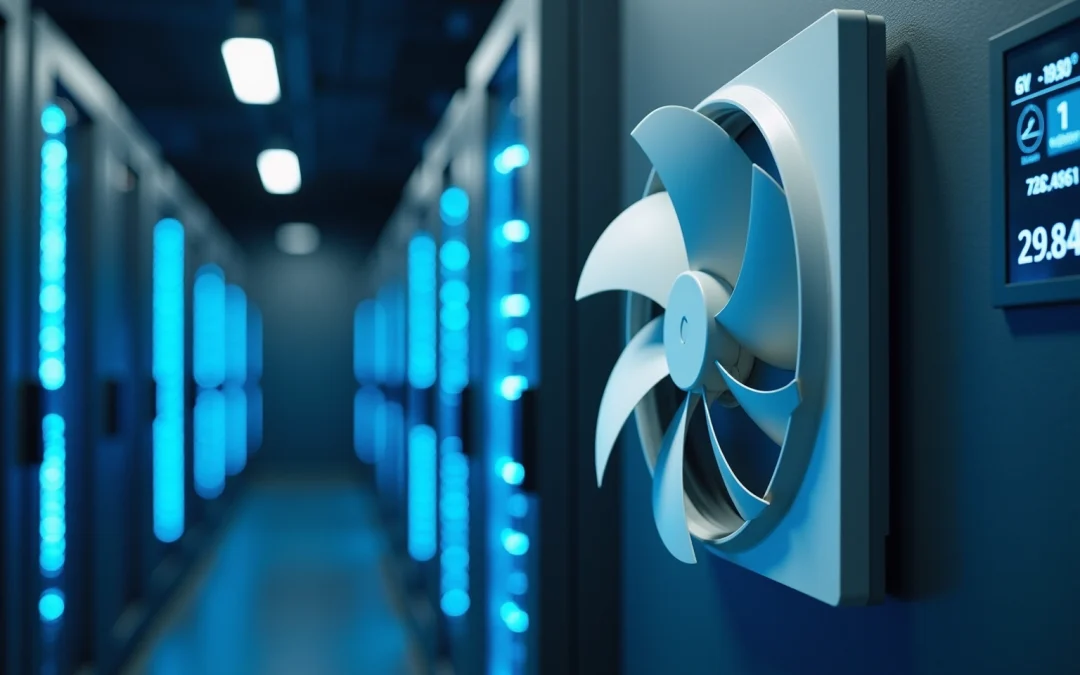Overview
The significant advantages of EC fans for electronics engineers encompass enhanced energy efficiency, reduced maintenance requirements, and superior performance control. Notably, EC fans can consume up to 70% less power than traditional AC fans, thereby addressing energy consumption concerns effectively. Their brushless design contributes to longer lifespans, further reducing the need for frequent replacements. Additionally, integrated controls facilitate dynamic adjustments based on real-time cooling demands, making EC fans a compelling choice for modern applications. This combination of features not only enhances operational efficiency but also positions EC fans as a strategic solution for contemporary engineering challenges.
Introduction
The evolution of cooling technology has ushered in Electronically Commutated (EC) fans, which seamlessly integrate the strengths of both AC and DC systems to deliver exceptional performance. For electronics engineers, grasping the advantages of EC fans is paramount, as these devices not only enhance energy efficiency but also promise significant cost savings and extended longevity.
However, with a plethora of options available, how can engineers ascertain the most suitable applications for these innovative solutions? Furthermore, what challenges might they encounter during implementation?
Define EC Fan Technology and Its Mechanisms
Electronically Commutated (EC) units represent a significant advancement in technology, merging the benefits of both AC and DC systems. These devices utilize a brushless DC motor, governed by an integrated electronic circuit, which enhances performance and control. The key mechanisms include:
- Brushless Motor Design: EC fans eliminate the necessity for brushes, which are susceptible to wear, resulting in operational lifespans of 8-15 years and reduced maintenance needs. This design not only minimizes downtime but also fosters a cleaner operational environment by decreasing carbon dust.
- Integrated Control: The onboard electronics enable precise speed modulation, allowing the fan to dynamically adjust its performance in response to real-time cooling demands. This adaptability is essential in settings where cooling requirements vary, such as data centers and healthcare facilities.
- Energy Conservation: Capable of achieving performance levels of up to 90%, EC units consume significantly less power than traditional AC devices, which typically operate at constant speeds. In fact, EC devices can use up to 50% less electricity than AC motors. This efficiency leads to , particularly in high-energy sectors like commercial buildings and data centers, where cooling systems account for a considerable portion of electricity expenses.
By understanding these mechanisms, engineers can effectively leverage the EC fan advantages to optimize performance and sustainability in their designs. Case studies, such as ‘EC Fans Make Cooling More Efficient and Sustainable,’ have shown that the EC fan advantages include savings of up to 70% compared to standard AC units, positioning them as a compelling option for modern applications. Although the initial investment for EC motors may exceed that of AC and DC motors, the long-term savings and advantages validate the expenditure.
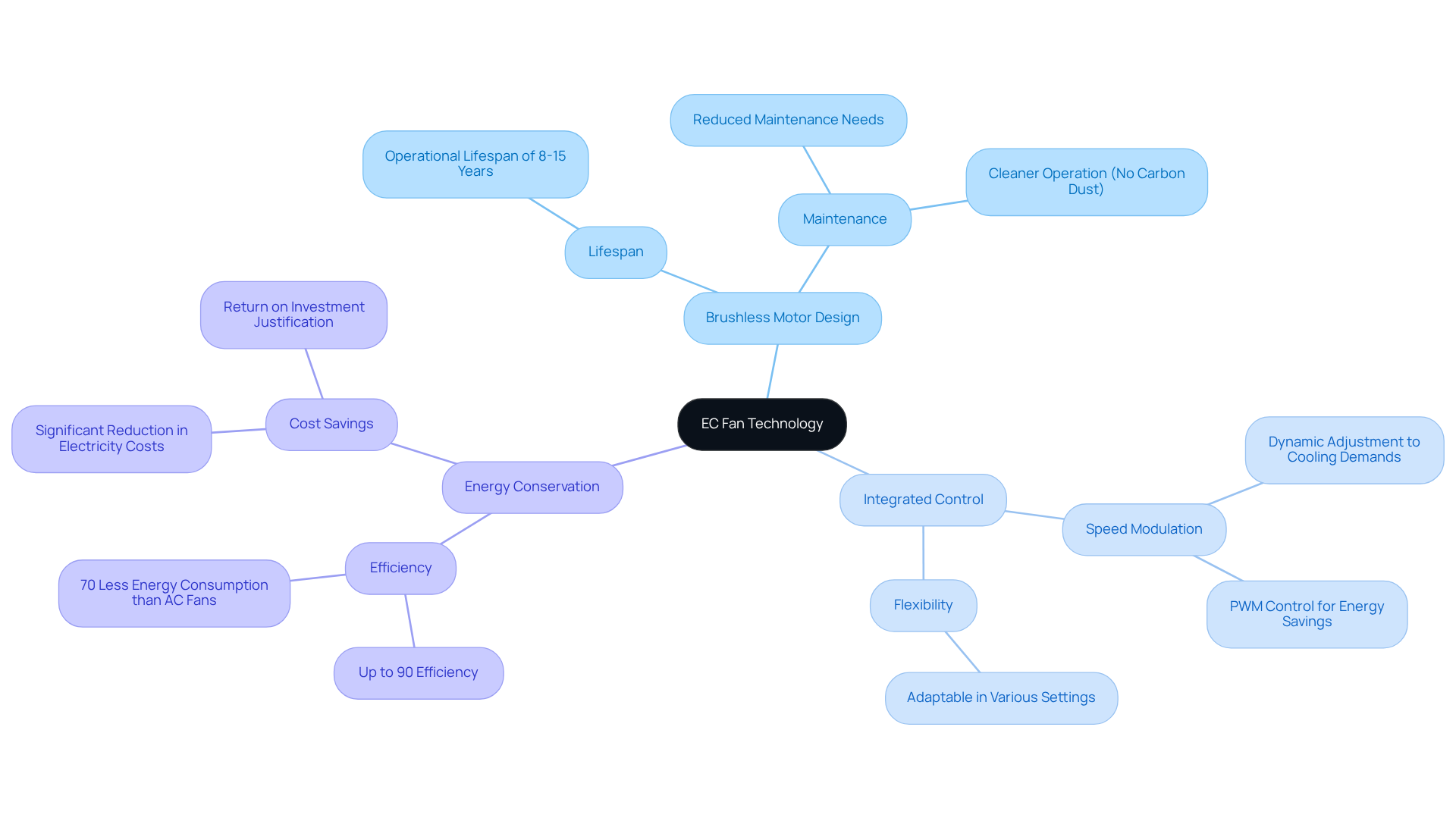
Explore the Efficiency and Cost Benefits of EC Fans
EC fan advantages include remarkable efficiency and cost savings that can significantly influence project budgets and operational expenses.
- Reduced Energy Consumption: EC fans are engineered for high efficiency, consuming up to 70% less power compared to traditional AC fans. This reduction is particularly significant in large-scale applications like data centers, where . For instance, the University of Melbourne reported a 70% reduction in energy consumption after substituting obsolete AC units with EC models, demonstrating the EC fan advantages and resulting in yearly savings surpassing $2,000.
- Lower Operating Costs: The extended lifespan of EC devices, frequently exceeding that of conventional models due to their brushless design, adds to their durability and reliability. This longevity minimizes the need for frequent replacements and maintenance, resulting in lower overall operating costs. The absence of brushes and high-quality materials further enhances their performance and reduces maintenance requirements.
- Incentives and Rebates: Numerous utility companies offer incentives for adopting energy-efficient technologies such as EC motors, which can assist in reducing initial investment expenses. These monetary motivations prompt engineers to incorporate EC blowers into their designs, optimizing both resource savings and project feasibility.
By integrating EC motors into their frameworks, engineers can capitalize on the EC fan advantages, achieving significant savings over the lifecycle of their projects while aligning with sustainability objectives and improving operational performance.
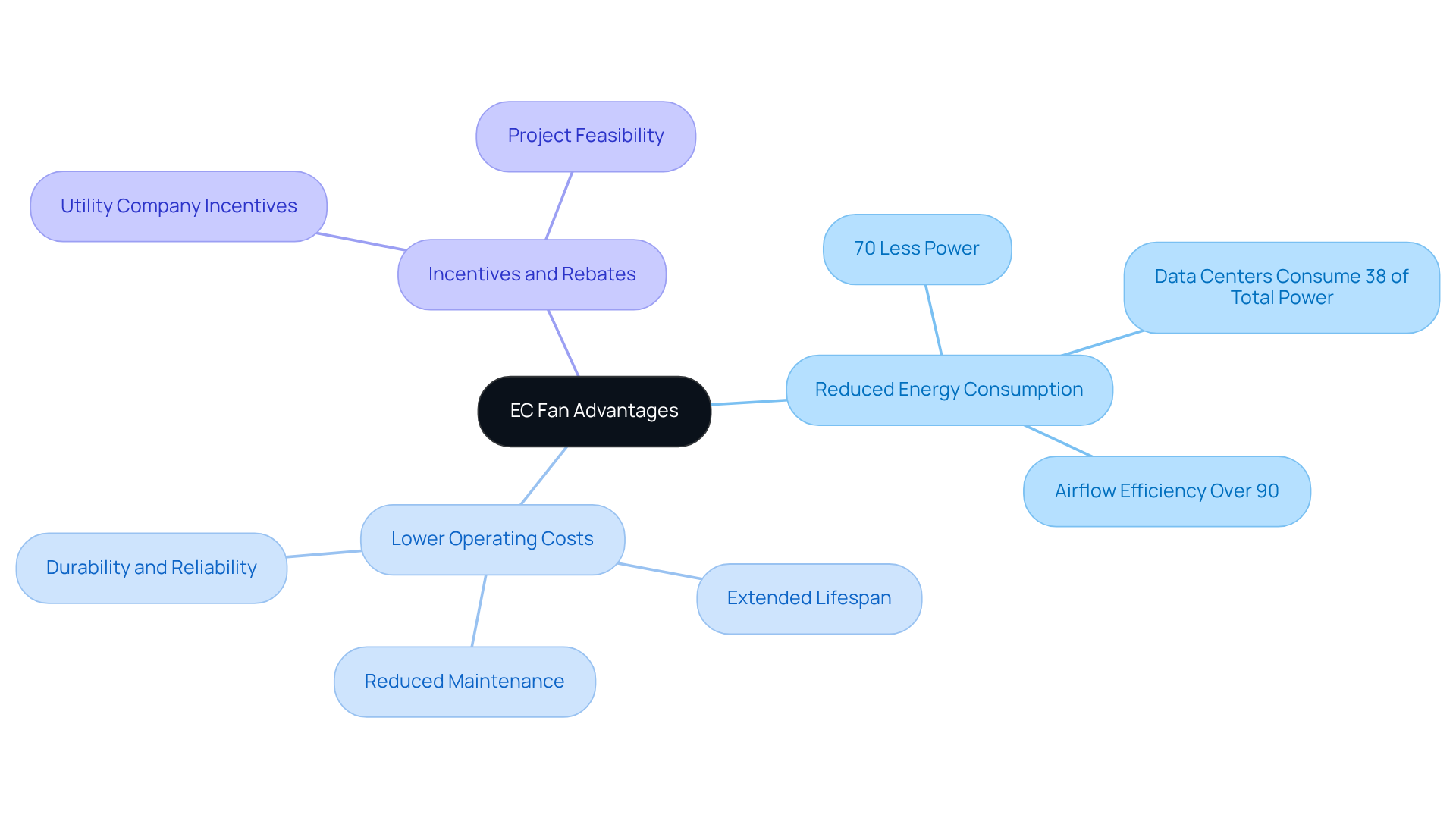
Examine Applications of EC Fans in Data Centers and HVAC Systems
The efficiency and performance of EC fans in critical applications such as data centers and HVAC systems highlight the EC fan advantages.
Data Centers: In environments where cooling is essential, EC fans deliver precise airflow control, significantly reducing energy consumption while maintaining optimal temperatures for servers. They can use up to than conventional air circulation devices, showcasing the EC fan advantages as an eco-friendly option for power-intensive facilities. Notably, running cooling and ventilation units represents about 40% of overall electricity expenses in data centers, underscoring the significance of these cost reductions. The deployment of COPRA EC devices, tailored specifically for data centers and adhering to IT industry-wide standards, highlights the EC fan advantages by proving to improve performance and sustainability, effectively addressing HVAC challenges.
In HVAC solutions, the EC fan advantages are that they enhance energy efficiency and lower noise levels in heating, ventilation, and air conditioning setups, making them suitable for both commercial and residential applications. Their streamlined internal motor and aerodynamic impeller designs eliminate airflow barriers, resulting in a smaller carbon footprint compared to traditional models. As the industry progresses towards smart infrastructure, the integration of EC devices with building management frameworks is becoming increasingly common, signaling a broader trend in the sector.
Industrial Processes: Numerous manufacturing methods necessitate dependable cooling solutions, and EC units can be customized to meet specific airflow and pressure specifications. Their adaptability allows for scalable solutions tailored to the size and ventilation needs of various facilities.
These applications highlight the versatility and effectiveness of EC devices in enhancing system performance across various industries, which illustrates the EC fan advantages in addressing the growing demand for energy-efficient technologies.
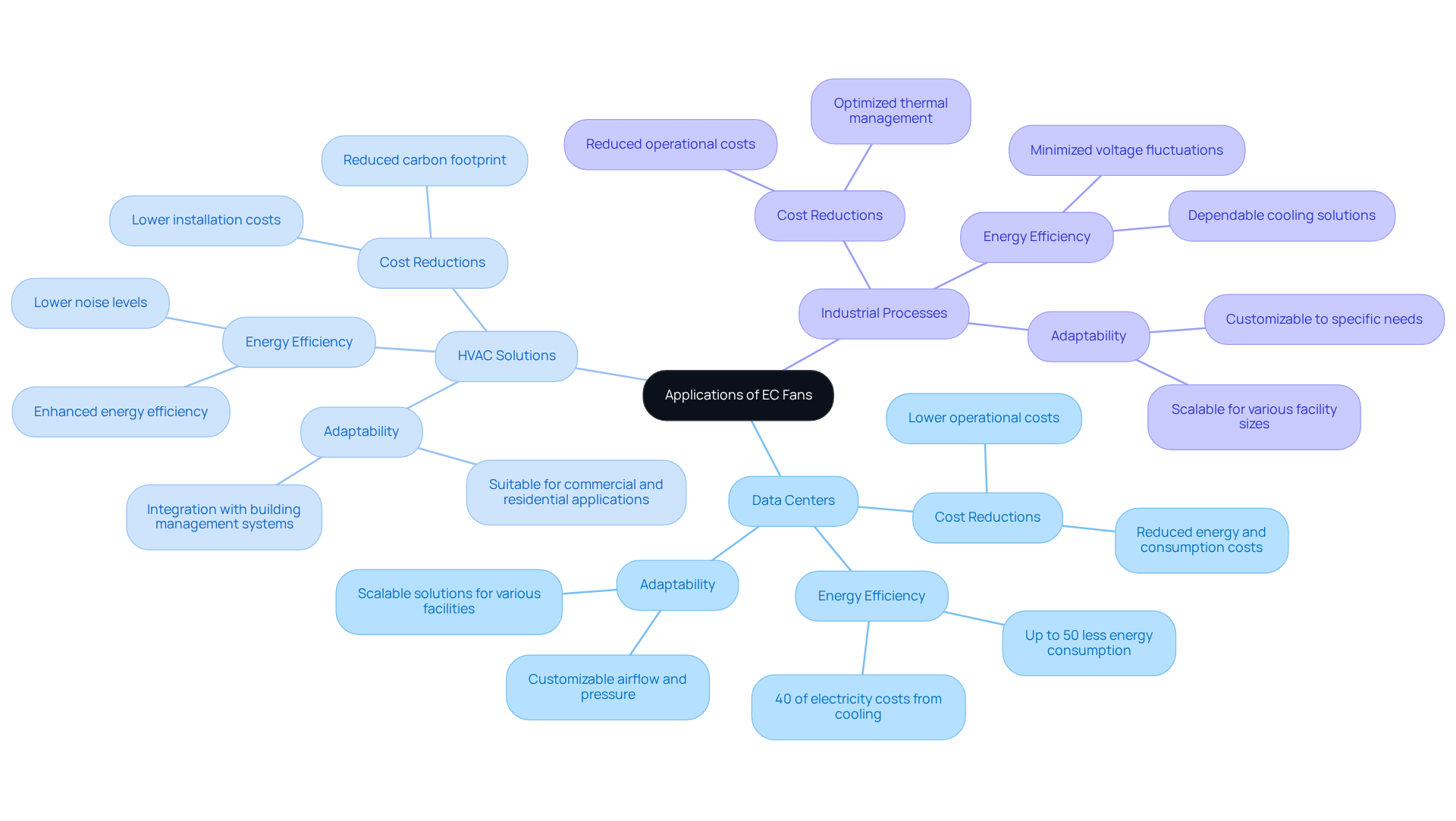
Discuss Future Trends and Innovations in EC Fan Technology
The future of EC fan technology is poised for transformative advancements that will significantly enhance the EC fan advantages in functionality and efficiency.
- Smart Technology Integration: The rapid expansion of the Internet of Things (IoT) is set to elevate EC fans with smart capabilities. This integration will facilitate remote monitoring and control, enabling real-time adjustments based on environmental conditions and operational demands. Such advancements will not only enhance performance but also offer EC fan advantages by contributing to energy conservation, as devices can adjust airflow according to varying IT loads. As John Palomba, Director VAC at ebm-papst Inc., asserts, ‘In an era where every watt counts, the EC fan advantages provide a clear path forward—one that supports both operational excellence and environmental responsibility.’
- Advanced Materials: Innovations in materials science are paving the way for the creation of lighter and more durable fan designs. These advancements will enhance efficiency while simultaneously reducing noise levels, showcasing the EC fan advantages that make EC devices more suitable for sensitive environments such as data centers and residential applications.
- Sustainability Focus: With the global emphasis on sustainability intensifying, future EC fans will likely prioritize eco-friendly manufacturing processes and materials. This shift aligns with the growing demand for , as evidenced by the projected growth of the market, highlighting the EC fan advantages, which is expected to reach USD 5.6 billion by 2033, growing at a CAGR of 6.5% from 2026 to 2033. The integration of sustainable practices will not only meet regulatory requirements but also resonate with environmentally conscious consumers. However, challenges such as high initial costs and the need for skilled technicians may hinder broader adoption.
By staying informed about these trends, engineers can effectively navigate the evolving landscape of electronic cooling solutions, ensuring they leverage the latest technologies to enhance system performance and sustainability, as well as to take advantage of EC fan advantages.
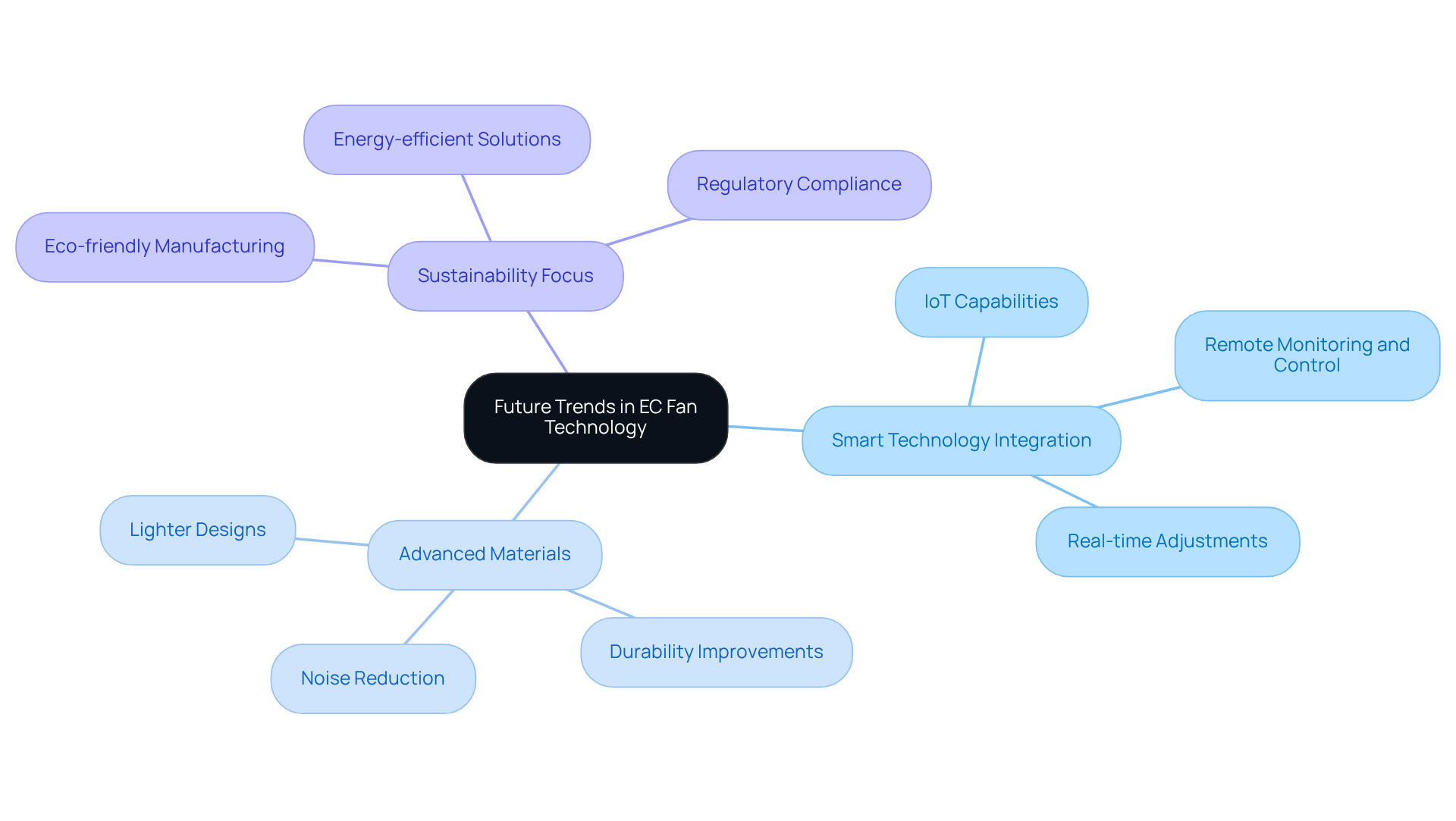
Conclusion
The exploration of Electronically Commutated (EC) fan technology underscores its pivotal role in modern engineering, especially for electronics engineers focused on enhancing efficiency and sustainability. By merging the benefits of both AC and DC systems, EC fans emerge as a superior choice, delivering substantial operational advantages that can revolutionize design practices and energy management.
Key points throughout the article include:
- The brushless motor design
- Integrated control systems
- Exceptional energy conservation capabilities
These aspects accentuate the benefits of EC fans. Their capacity to dynamically adjust performance, reduce energy consumption by up to 70%, and lower overall operating costs renders them an appealing option for critical applications in data centers, HVAC systems, and various industrial processes.
Furthermore, the potential for future innovations, including smart technology integration and sustainable manufacturing practices, positions EC fans as a forward-thinking solution in the pursuit of energy efficiency.
As the demand for energy-efficient technologies escalates, embracing EC fan technology is not merely a choice but a necessity for engineers aiming to optimize performance and curtail costs. By capitalizing on the advantages of EC fans, professionals can contribute to a more sustainable future while enhancing the reliability and effectiveness of their systems.
Transitioning to EC fans represents a strategic move toward not only meeting regulatory requirements but also achieving long-term savings and operational excellence in an increasingly energy-conscious world.
Frequently Asked Questions
What is EC fan technology?
Electronically Commutated (EC) fan technology combines the benefits of AC and DC systems, using a brushless DC motor controlled by an integrated electronic circuit for enhanced performance and control.
What are the main components of EC fan technology?
The main components include a brushless motor design, integrated control for speed modulation, and energy conservation features.
How does the brushless motor design benefit EC fans?
The brushless motor design eliminates the need for brushes, which wear out over time, resulting in operational lifespans of 8-15 years and reduced maintenance needs, leading to less downtime and a cleaner environment.
What is the role of integrated control in EC fans?
Integrated control allows for precise speed modulation, enabling the fan to adjust its performance dynamically based on real-time cooling demands, which is crucial in varying environments like data centers and healthcare facilities.
How do EC fans compare to traditional AC devices in terms of energy consumption?
EC fans are significantly more energy-efficient, achieving performance levels of up to 90% and consuming up to 50% less electricity than traditional AC motors, which typically operate at constant speeds.
What cost savings can be expected from using EC fans?
EC fans can lead to substantial cost savings, particularly in high-energy sectors like commercial buildings and data centers, where cooling systems can account for a large portion of electricity expenses. Case studies indicate savings of up to 70% compared to standard AC units.
Are there any initial cost considerations for EC fans?
While the initial investment for EC motors may be higher than that of AC and DC motors, the long-term savings and operational advantages justify the expenditure.

